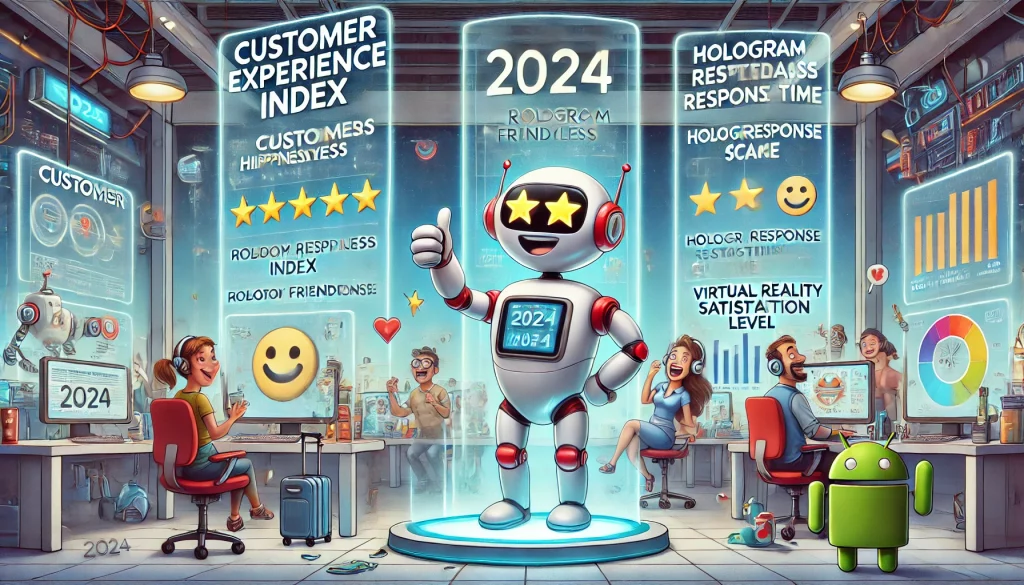Сustomer experience metrics in 2024: Boost satisfaction and loyalty
Content:
Definition of customer experience (CX)
Why customer experience metrics matter
Key metrics to track
How to effectively measure and analyze CX metrics
Leveraging technology for better CX insights
Numbers and facts
Expert opinions on customer experience metrics

Imagine a customer who walks into your store, receives exceptional service, and leaves with a smile, only to never return. Why? Because you didn’t measure their experience.
In today’s competitive business landscape, understanding and enhancing customer experience (CX) is crucial for success. This article explores the significance of CX metrics and how they can drive business growth.
Tracking and analyzing customer experience metrics is essential for building customer loyalty, improving satisfaction, and driving business growth.
This article will cover the importance of customer experience metrics, essential CX metrics for 2024, how to effectively measure and analyze these metrics, the role of technology in enhancing CX insights, and real-world examples of small businesses successfully using CX metrics.
Definition of customer experience (CX)
Customer experience (CX) refers to the sum of all interactions a customer has with a brand, including the quality of service, product, and overall engagement. It encompasses every touchpoint from initial contact to post-purchase interactions.
Why customer experience metrics matter
Customer experience metrics are critical in shaping business strategy and customer satisfaction.
Building customer loyalty
Tracking CX metrics helps identify loyal customers and fosters repeat business. By understanding which customers are most loyal and why businesses can tailor their strategies to maintain and enhance these relationships.
Loyalty programs and personalized marketing are effective tools that can be developed based on these insights.
Improving customer satisfaction
Metrics provide insights into customer preferences and pain points, enabling businesses to enhance service quality. Understanding what makes customers happy or unhappy allows businesses to make targeted improvements, leading to better overall satisfaction.
This can include changes in product offerings, service protocols, or customer support practices.
Driving business growth
Positive customer experiences correlate with increased revenue. Satisfied customers are more likely to make repeat purchases, recommend the business to others, and contribute to a positive brand reputation. Tracking CX metrics helps businesses identify and replicate the factors that lead to these positive outcomes, driving growth and profitability.
Key metrics to track
Identifying and describing the most important CX metrics that small businesses should monitor in 2024.
Net promoter score (NPS)
NPS measures customer loyalty and likelihood to recommend a business. It is calculated based on responses to a single question: “How likely are you to recommend our company/product/service to a friend or colleague?”
Customers are categorized as promoters, passives, or detractors, and the score is derived by subtracting the percentage of detractors from the percentage of promoters. Monitoring NPS helps businesses gauge overall customer loyalty and identify areas for improvement.
Customer satisfaction score (CSAT)
CSAT measures immediate customer satisfaction after an interaction. It typically involves a short survey asking customers to rate their satisfaction with a recent purchase or service experience on a scale from very unsatisfied to very satisfied.
CSAT scores provide direct feedback on specific aspects of the customer experience, enabling businesses to address issues promptly and improve service quality.
Customer Effort Score (CES)
CES assesses how easily customers can resolve their issues. It asks customers to rate the ease of their experience in solving a problem or completing a transaction.
High effort scores indicate that customers find the process challenging or frustrating, which can lead to dissatisfaction and churn. Reducing customer effort by streamlining processes and improving support can enhance overall satisfaction and loyalty.
Churn rate and retention metrics
Churn rate measures the percentage of customers who stop doing business with a company over a specific period, while retention metrics track the percentage of customers who continue to make purchases. High churn rates can indicate underlying issues with the product, service, or overall experience.
Monitoring these metrics helps businesses identify and address factors contributing to customer loss, thereby improving retention and long-term profitability.
Customer lifetime value (CLV)
CLV predicts the net profit linked to customer relationships over their entire lifecycle with the business. It considers factors such as purchase frequency, average order value, and customer lifespan.
By understanding CLV, businesses can make informed decisions about customer acquisition costs and retention strategies, focusing efforts on high-value customers to maximize profitability.
Other relevant metrics and indicators
Additional metrics like acquisition and conversion rates, first response times, first call resolution rates, and engagement rates also provide valuable insights into different aspects of the customer experience. Acquisition and conversion rates track the effectiveness of marketing efforts in attracting and converting new customers.
First response and resolution times measure the efficiency of customer support. Engagement rates indicate how actively customers interact with the brand across various channels.

How to effectively measure and analyze CX metrics
A practical guide on collecting, analyzing, and acting on CX metrics.
Data collection methods: Discuss various methods for collecting CX data, such as surveys, feedback forms, and digital analytics. Surveys and feedback forms can be administered after transactions or interactions to gather immediate responses.
Digital analytics tools track customer behavior on websites and apps, providing insights into user experience and engagement patterns. Combining these methods ensures comprehensive data collection.
Analyzing data: Explain how to interpret data collected from different metrics. Analyzing CX data involves identifying trends, patterns, and outliers.
Businesses can use statistical tools and software to process large datasets, visualize findings, and extract actionable insights. Regular analysis helps in understanding customer behavior, preferences, and areas needing improvement.
Taking action: Provide strategies for implementing changes based on CX data. Acting on CX insights involves making targeted improvements to products, services, and processes.
This can include training staff, enhancing support systems, refining marketing strategies, and updating product features. Continuous feedback loops ensure that changes lead to measurable improvements in customer experience.
Leveraging technology for better CX insights
Exploring how modern technology can enhance the tracking and utilization of CX metrics.
AI and Machine Learning
Describe how AI and machine learning can predict customer behavior and preferences. These technologies analyze vast amounts of data to identify patterns and make predictions.
They can be used for personalized marketing, proactive customer support, and optimizing product recommendations. Implementing AI tools helps businesses stay ahead by anticipating customer needs and delivering tailored experiences.
Customer Relationship Management (CRM) Systems
Explain the benefits of integrating CRM systems for a holistic view of customer interactions. CRM systems centralize customer data, including contact information, purchase history, and interaction records.
This enables businesses to track and manage customer relationships effectively, providing insights into customer behavior and preferences. Popular CRM platforms offer various features like automated marketing, customer segmentation, and performance analytics.
Omnichannel Feedback
Highlight the importance of collecting feedback across multiple channels (in-store, online, social media). Omnichannel feedback ensures that businesses capture a complete picture of the customer experience.
Consistency in feedback collection and analysis across different channels helps in identifying common issues and improving overall customer satisfaction. Implementing tools for real-time feedback and monitoring social media interactions are crucial for a comprehensive approach.

Numbers and facts
In 2024, businesses that prioritize customer experience are seeing average CSAT scores of 85% or higher.
Companies with strong customer experience strategies report NPS scores above 60, indicating high levels of customer loyalty.
Firms with excellent customer experience practices achieve retention rates upwards of 90%, compared to the industry average of 75%.
Leading companies are focusing on reducing customer effort, with average CES improving to 3 or lower on a 5-point scale.
For every 1-point increase in NPS, companies can expect a 5% increase in revenue.
Companies with high customer experience ratings also report employee engagement scores above 80%, showing a correlation between happy employees and satisfied customers.
Enhanced customer experience strategies lead to a 20-40% increase in CLV.
Top-performing businesses resolve customer issues on the first contact 80% of the time.
Over 70% of customers expect seamless interactions across multiple channels; businesses investing in omni-channel strategies report 23% higher customer satisfaction rates.
60% of customer interactions are expected to involve AI-driven technology by 2024, improving response times and personalization.

Expert opinions on customer experience metrics
Dr. Olivia Carter, CX Research Analyst at Future Insights “In 2024, the importance of real-time analytics in customer experience metrics cannot be overstated. By leveraging advanced AI algorithms, companies are now able to predict customer behavior with remarkable accuracy. This predictive capability allows businesses to proactively address potential issues, enhancing customer satisfaction and loyalty. The real game-changer, however, is the integration of sentiment analysis into customer feedback loops, providing deeper insights into emotional responses and driving more personalized service strategies.”
Johnathan Smith, CEO of CustomerFirst Consulting “Customer experience metrics in 2024 have evolved beyond traditional satisfaction surveys. Today, the focus is on holistic customer journey analytics. By mapping every touchpoint, from initial contact to post-purchase support, companies can identify pain points and optimize the customer experience. The use of omnichannel data collection has been instrumental in this process, offering a unified view of customer interactions across multiple platforms. This comprehensive approach not only boosts customer satisfaction but also drives higher retention rates and increased lifetime value.”
Linda Martinez, Director of CX at TechInnovate “One of the most significant trends in customer experience metrics this year is the emphasis on Customer Effort Score (CES). Customers are increasingly valuing convenience and ease of interaction over traditional metrics like Net Promoter Score (NPS). By minimizing the effort required to engage with products and services, companies can significantly enhance the overall experience. This shift towards CES has led to innovative solutions such as automated self-service options and streamlined customer support processes, ultimately fostering greater customer loyalty.”

 9 min
9 min 







